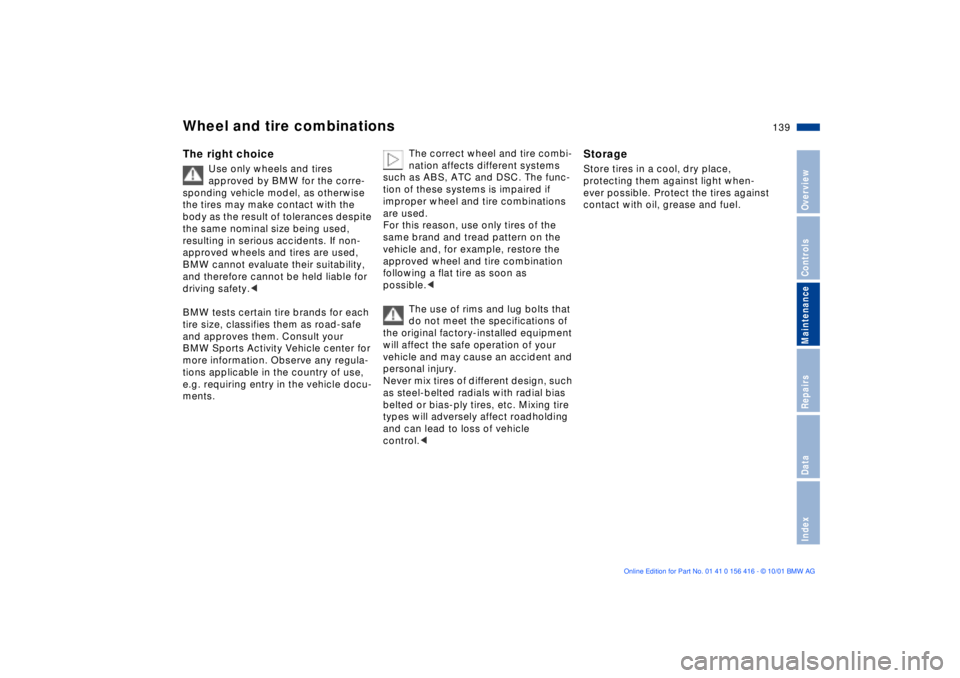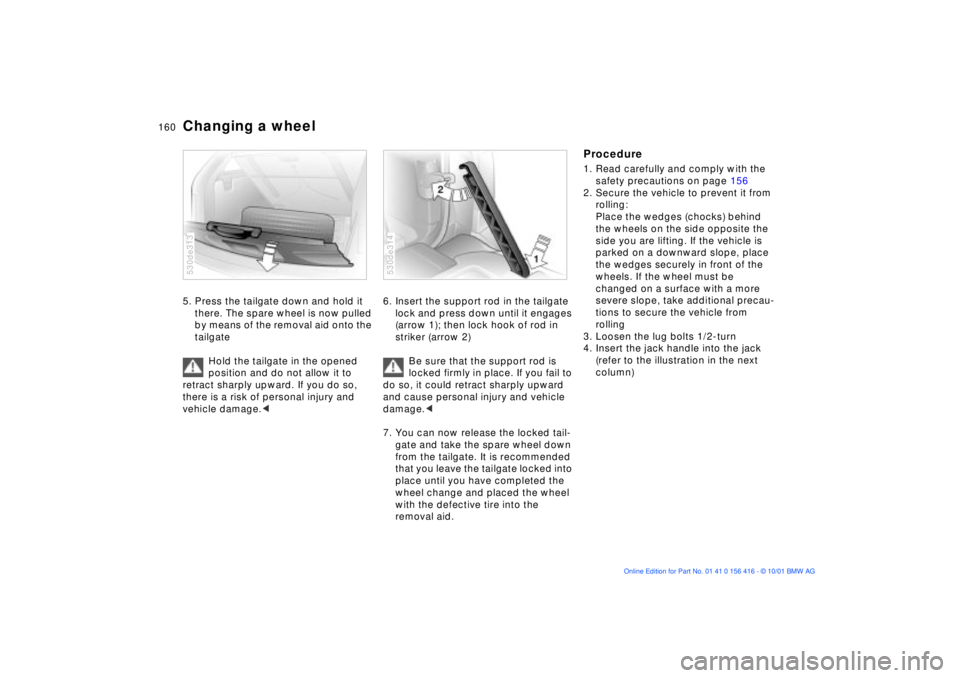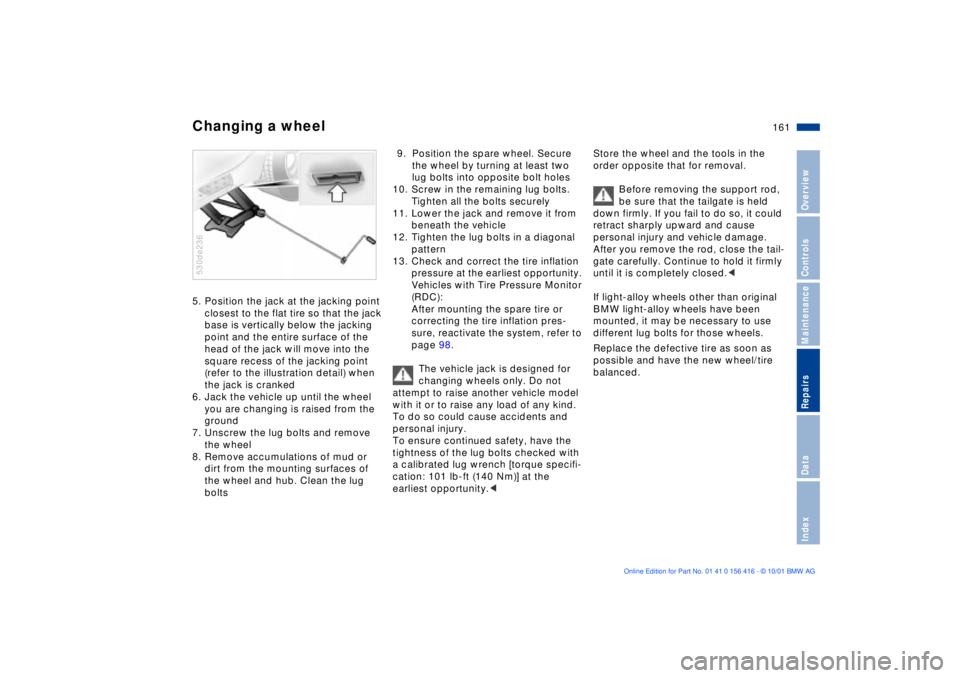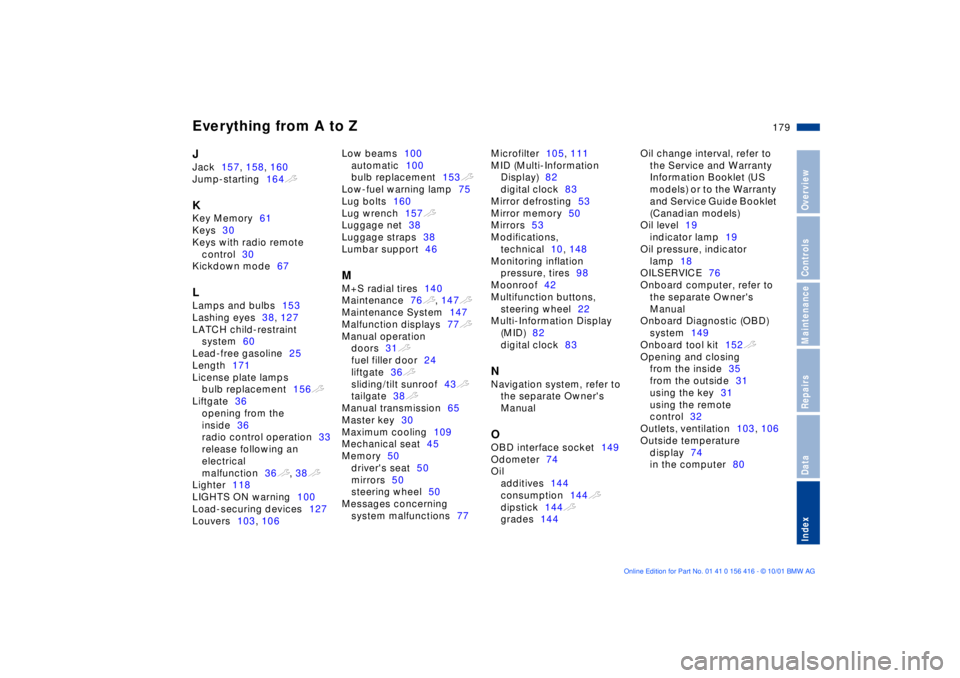wheel bolts BMW X5 4.4I 2002 Owners Manual
[x] Cancel search | Manufacturer: BMW, Model Year: 2002, Model line: X5 4.4I, Model: BMW X5 4.4I 2002Pages: 185, PDF Size: 2.7 MB
Page 139 of 185

139n
OverviewControlsMaintenanceRepairsDataIndex
Wheel and tire combinations The right choice
Use only wheels and tires
approved by BMW for the corre-
sponding vehicle model, as otherwise
the tires may make contact with the
body as the result of tolerances despite
the same nominal size being used,
resulting in serious accidents. If non-
approved wheels and tires are used,
BMW cannot evaluate their suitability,
and therefore cannot be held liable for
driving safety.<
BMW tests certain tire brands for each
tire size, classifies them as road-safe
and approves them. Consult your
BMW Sports Activity Vehicle center for
more information. Observe any regula-
tions applicable in the country of use,
e.g. requiring entry in the vehicle docu-
ments.
The correct wheel and tire combi-
nation affects different systems
such as ABS, ATC and DSC. The func-
tion of these systems is impaired if
improper wheel and tire combinations
are used.
For this reason, use only tires of the
same brand and tread pattern on the
vehicle and, for example, restore the
approved wheel and tire combination
following a flat tire as soon as
possible.<
The use of rims and lug bolts that
do not meet the specifications of
the original factory-installed equipment
will affect the safe operation of your
vehicle and may cause an accident and
personal injury.
Never mix tires of different design, such
as steel-belted radials with radial bias
belted or bias-ply tires, etc. Mixing tire
types will adversely affect roadholding
and can lead to loss of vehicle
control.<
Storage Store tires in a cool, dry place,
protecting them against light when-
ever possible. Protect the tires against
contact with oil, grease and fuel.
Page 160 of 185

160n
Changing a wheel 5. Press the tailgate down and hold it
there. The spare wheel is now pulled
by means of the removal aid onto the
tailgate
Hold the tailgate in the opened
position and do not allow it to
retract sharply upward. If you do so,
there is a risk of personal injury and
vehicle damage.< 530de313
6. Insert the support rod in the tailgate
lock and press down until it engages
(arrow 1); then lock hook of rod in
striker (arrow 2)
Be sure that the support rod is
locked firmly in place. If you fail to
do so, it could retract sharply upward
and cause personal injury and vehicle
damage.<
7. You can now release the locked tail-
gate and take the spare wheel down
from the tailgate. It is recommended
that you leave the tailgate locked into
place until you have completed the
wheel change and placed the wheel
with the defective tire into the
removal aid. 530de314
Procedure1. Read carefully and comply with the
safety precautions on page 156
2. Secure the vehicle to prevent it from
rolling:
Place the wedges (chocks) behind
the wheels on the side opposite the
side you are lifting. If the vehicle is
parked on a downward slope, place
the wedges securely in front of the
wheels. If the wheel must be
changed on a surface with a more
severe slope, take additional precau-
tions to secure the vehicle from
rolling
3. Loosen the lug bolts 1/2-turn
4. Insert the jack handle into the jack
(refer to the illustration in the next
column)
Page 161 of 185

161n
OverviewControlsMaintenanceRepairsDataIndex
Changing a wheel5. Position the jack at the jacking point
closest to the flat tire so that the jack
base is vertically below the jacking
point and the entire surface of the
head of the jack will move into the
square recess of the jacking point
(refer to the illustration detail) when
the jack is cranked
6. Jack the vehicle up until the wheel
you are changing is raised from the
ground
7. Unscrew the lug bolts and remove
the wheel
8. Remove accumulations of mud or
dirt from the mounting surfaces of
the wheel and hub. Clean the lug
bolts 530de236
9. Position the spare wheel. Secure
the wheel by turning at least two
lug bolts into opposite bolt holes
10. Screw in the remaining lug bolts.
Tighten all the bolts securely
11. Lower the jack and remove it from
beneath the vehicle
12. Tighten the lug bolts in a diagonal
pattern
13. Check and correct the tire inflation
pressure at the earliest opportunity.
Vehicles with Tire Pressure Monitor
(RDC):
After mounting the spare tire or
correcting the tire inflation pres-
sure, reactivate the system, refer to
page 98.
The vehicle jack is designed for
changing wheels only. Do not
attempt to raise another vehicle model
with it or to raise any load of any kind.
To do so could cause accidents and
personal injury.
To ensure continued safety, have the
tightness of the lug bolts checked with
a calibrated lug wrench [torque specifi-
cation: 101 lb-ft (140 Nm)] at the
earliest opportunity.<
Store the wheel and the tools in the
order opposite that for removal.
Before removing the support rod,
be sure that the tailgate is held
down firmly. If you fail to do so, it could
retract sharply upward and cause
personal injury and vehicle damage.
After you remove the rod, close the tail-
gate carefully. Continue to hold it firmly
until it is completely closed.<
If light-alloy wheels other than original
BMW light-alloy wheels have been
mounted, it may be necessary to use
different lug bolts for those wheels.
Replace the defective tire as soon as
possible and have the new wheel/tire
balanced.
Page 179 of 185

Everything from A to Z
179n
OverviewControlsMaintenanceRepairsDataIndex
JJack157, 158, 160
Jump-starting164tKKey Memory61
Keys30
Keys with radio remote
control30
Kickdown mode67LLamps and bulbs153
Lashing eyes38, 127
LATCH child-restraint
system60
Lead-free gasoline25
Length171
License plate lamps
bulb replacement156t
Liftgate36
opening from the
inside36
radio control operation33
release following an
electrical
malfunction36t, 38t
Lighter118
LIGHTS ON warning100
Load-securing devices127
Louvers103, 106Low beams100
automatic100
bulb replacement153t
Low-fuel warning lamp75
Lug bolts160
Lug wrench157t
Luggage net38
Luggage straps38
Lumbar support46
MM+S radial tires140
Maintenance76t, 147t
Maintenance System147
Malfunction displays77t
Manual operation
doors31t
fuel filler door24
liftgate36t
sliding/tilt sunroof43t
tailgate38t
Manual transmission65
Master key30
Maximum cooling109
Mechanical seat45
Memory50
driver's seat50
mirrors50
steering wheel50
Messages concerning
system malfunctions77Microfilter105, 111
MID (Multi-Information
Display)82
digital clock83
Mirror defrosting53
Mirror memory50
Mirrors53
Modifications,
technical10, 148
Monitoring inflation
pressure, tires98
Moonroof42
Multifunction buttons,
steering wheel22
Multi-Information Display
(MID)82
digital clock83
NNavigation system, refer to
the separate Owner's
ManualOOBD interface socket149
Odometer74
Oil
additives144
consumption144t
dipstick144t
grades144Oil change interval, refer to
the Service and Warranty
Information Booklet (US
models) or to the Warranty
and Service Guide Booklet
(Canadian models)
Oil level19
indicator lamp19
Oil pressure, indicator
lamp18
OILSERVICE76
Onboard computer, refer to
the separate Owner's
Manual
Onboard Diagnostic (OBD)
system149
Onboard tool kit152t
Opening and closing
from the inside35
from the outside31
using the key31
using the remote
control32
Outlets, ventilation103, 106
Outside temperature
display74
in the computer80